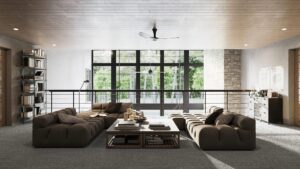
Interior visualization in architecture is a crucial tool that allows architects, designers, and clients to visualize and understand the design of interior spaces before they are built. This process involves creating realistic and detailed visual representations of interior designs, enabling stakeholders to make informed decisions and ensure that the final result meets their expectations. In this article, we will delve into the essentials of interior visualization in architecture.
**1. Importance of Interior Visualization
Interior visualization is essential for several reasons:
- Design Clarity: It helps communicate design concepts, materials, colors, and spatial arrangements effectively.
- Client Engagement: Clients can better understand and visualize the proposed design, leading to informed decisions.
- Error Reduction: Identifying design flaws or conflicts before construction minimizes costly changes later.
- Marketing and Presentation: High-quality visualizations can be used for marketing and attracting potential buyers or investors.
**2. Types of Interior Visualization
There are several types of interior visualization methods:
- 2D Drawings: Traditional floor plans, elevations, and sections provide a basic visual representation of spaces and layouts.
- 3D Models: Three-dimensional digital models allow stakeholders to view spaces from multiple angles and perspectives.
- Renderings: Photorealistic renderings provide a detailed and lifelike representation of interior spaces, including lighting, textures, and materials.
- Virtual Reality (VR): VR technology enables users to experience interior spaces in a fully immersive manner, making it a powerful tool for design validation and client presentations.
**3. Software and Tools
Interior visualization relies on specialized software and tools, including:
- Computer-Aided Design (CAD): CAD software is used to create precise 2D and 3D models of interior spaces.
- Rendering Software: Rendering software like Autodesk 3ds Max, V-Ray, or Lumion transforms 3D models into photorealistic images.
- Virtual Reality Platforms: VR platforms like Oculus Rift and HTC Vive offer immersive experiences for design exploration.
**4. Lighting and Textures
Lighting plays a pivotal role in interior visualization. Designers must accurately simulate natural and artificial lighting conditions to showcase how a space will look at different times of the day. Additionally, applying textures and materials to surfaces is crucial for conveying the tactile qualities of materials like wood, stone, or fabric.
**5. Scale and Proportions
Maintaining accurate scale and proportions in interior visualization is paramount. Oversights in this area can lead to misleading representations of space. Proper scaling ensures that furniture, fixtures, and architectural elements fit harmoniously within the design.
**6. Client Collaboration
Interior visualization facilitates collaboration between architects, designers, and clients. Regular feedback and discussions based on visualizations help refine the design and ensure it aligns with the client’s vision and expectations.
**7. Cost and Time Savings
While interior visualization requires an initial investment in software and expertise, it can ultimately save time and money. Identifying design flaws or changes in the early stages of a project minimizes costly modifications during construction.
**8. Realistic Renderings
Photorealistic renderings are often the highlight of interior visualization. These Architectural renderings showcase details such as materials, furniture, and lighting, creating a compelling and lifelike representation of the proposed design.
Conclusion
Interior visualization is an indispensable tool in modern architecture and interior design. It enhances communication, fosters client engagement, reduces errors, and ultimately leads to more successful and satisfying interior spaces. By leveraging technology, design expertise, and a keen eye for detail, professionals in the field can create stunning visualizations that bring interior designs to life, ensuring that the final result aligns with the intended vision.
